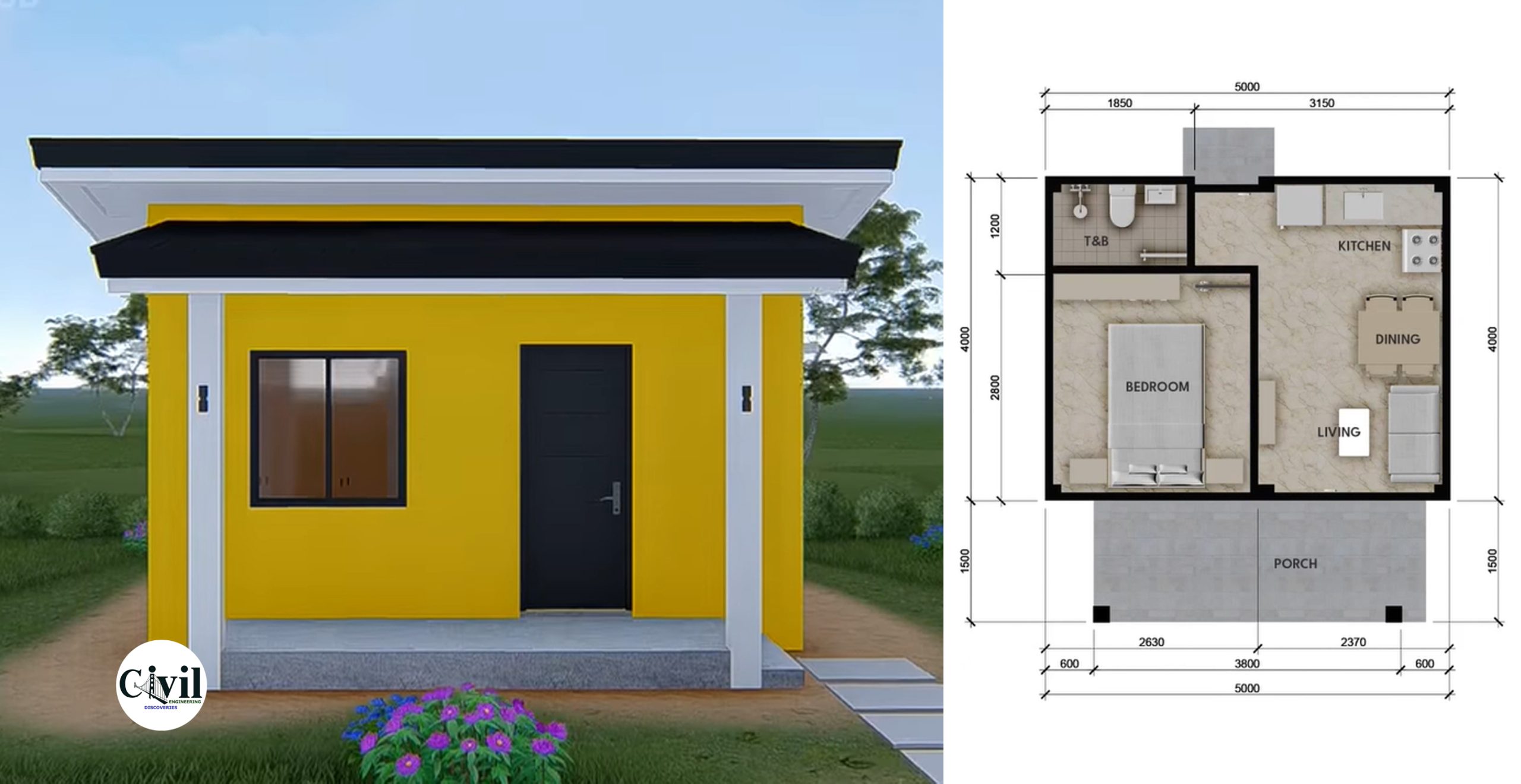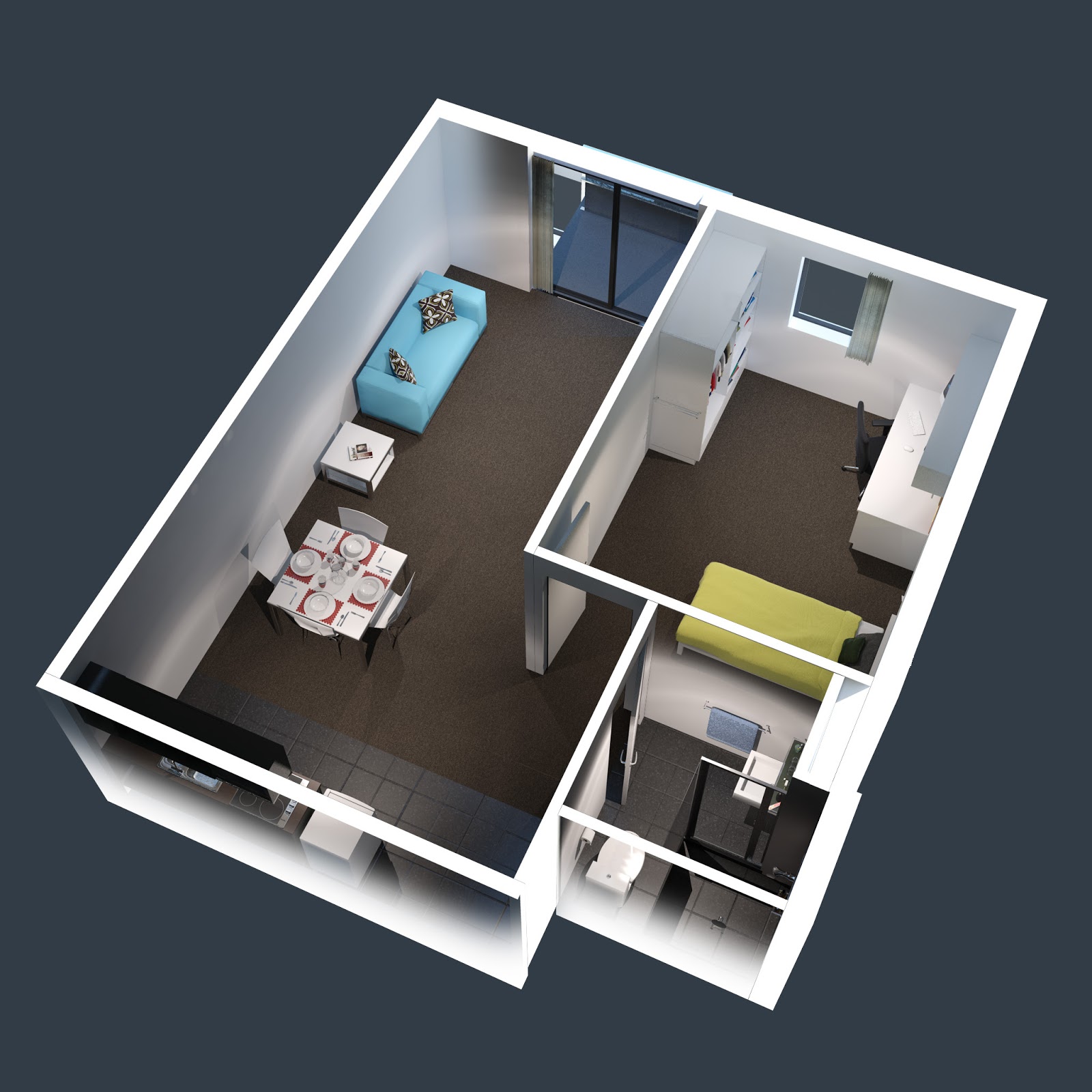Designing for Functionality and Comfort: Simple One Bedroom House Design

A well-designed one-bedroom house prioritizes functionality and comfort, making the most of every square foot. This means creating a sense of flow, maximizing natural light and ventilation, and incorporating clever storage solutions.
Maximizing Space and Creating Flow
An open floor plan is key to maximizing space in a one-bedroom house. By eliminating unnecessary walls, you create a sense of openness and visual flow. This also allows natural light to penetrate deeper into the space.
Clever Storage Solutions
Storage is crucial in a small space. Consider these clever solutions:
- Built-in shelves and cabinets: These maximize vertical space and keep clutter out of sight. They can be incorporated into walls, under stairs, or even behind the bed.
- Multi-functional furniture: A sofa bed, a coffee table with storage, or a bed frame with built-in drawers can all serve multiple purposes.
- Wall-mounted organizers: Utilize walls for storage with floating shelves, wall-mounted hooks, and magnetic strips for tools and utensils.
Maximizing Natural Light and Ventilation
Natural light is essential for creating a welcoming and spacious feel.
- Large windows: Strategically placed large windows maximize natural light and ventilation.
- Skylights: Skylights can bring in additional natural light and create a feeling of spaciousness.
- Light-colored walls and furniture: Reflect natural light and create a brighter, airier atmosphere.
Floor Plan Example
Imagine a one-bedroom house with an open floor plan that seamlessly combines the living room, dining area, and kitchen. The bedroom is tucked away in a corner, offering privacy. A large window in the living room allows natural light to flood the space. The kitchen features a small island with built-in storage and a breakfast bar. The bathroom is compact but functional, with a walk-in shower. The bedroom includes a built-in wardrobe and a window for ventilation. This layout emphasizes open space, natural light, and clever storage solutions, creating a comfortable and functional living space.
Style and Aesthetics
A one-bedroom home, despite its size, offers a blank canvas to express your personal style and create a space that feels both functional and visually appealing. Choosing the right interior design style can help you achieve a cohesive look and feel that reflects your personality and preferences.
Interior Design Styles for One-Bedroom Homes
Different interior design styles offer distinct aesthetics and can transform a one-bedroom home into a haven that suits your taste. Here are some popular styles that work well in smaller spaces:
- Minimalist: This style prioritizes simplicity and functionality, emphasizing clean lines, neutral colors, and minimal clutter. It creates a sense of spaciousness and tranquility, perfect for a small home. Minimalist décor often features geometric shapes, natural materials like wood and stone, and a limited color palette.
- Modern: Modern design embraces clean lines, geometric shapes, and a focus on functionality. It often incorporates bold colors, metallic accents, and sleek furniture pieces. This style is ideal for creating a sophisticated and contemporary feel.
- Farmhouse: This style evokes a rustic charm with its use of natural materials, warm colors, and vintage-inspired furniture. Think distressed wood, whitewashed walls, and cozy textures like linen and cotton. Farmhouse décor often incorporates floral patterns, antique accents, and a focus on creating a welcoming and inviting atmosphere.
- Scandinavian: This style emphasizes simplicity, functionality, and natural light. It often features light wood furniture, white walls, and pops of color in the form of textiles and artwork. Scandinavian design prioritizes natural materials, clean lines, and a minimalist approach.
Choosing a Color Palette
Color plays a crucial role in setting the mood and ambiance of a space. When choosing a color palette for your one-bedroom home, consider the following tips:
- Use Light Colors to Maximize Space: Light colors, such as white, cream, and pale blues and greens, reflect light and create a sense of spaciousness.
- Add Pops of Color with Accents: Introduce bolder colors through accent pieces like throw pillows, artwork, and rugs. This adds personality and visual interest without overwhelming the space.
- Consider the Natural Light: If your bedroom receives a lot of natural light, you can experiment with a wider range of colors. However, if the space is naturally dark, opt for lighter shades to brighten it up.
- Create a Cohesive Look: Choose colors that complement each other and create a harmonious feel. Use a color wheel as a guide for creating balanced and visually appealing color combinations.
Key Furniture Pieces and Décor Elements
Furniture and décor elements play a vital role in shaping the style and functionality of your one-bedroom home. Here are some key pieces and elements to consider:
- Multifunctional Furniture: Choose furniture that serves multiple purposes, such as a sofa bed or a coffee table with storage space. This helps maximize space and functionality in a small home.
- Storage Solutions: Invest in storage solutions that keep your belongings organized and out of sight. This can include shelves, drawers, ottomans with storage, or a wardrobe system.
- Statement Pieces: Introduce a few statement pieces that add personality and visual interest to the space. This could be a unique rug, a bold piece of artwork, or a distinctive lamp.
- Greenery: Plants bring life and freshness to any space. Incorporate greenery in the form of potted plants, hanging baskets, or a small herb garden.
- Personal Touches: Don’t forget to add personal touches that make your home feel uniquely yours. This could include family photos, souvenirs, or artwork that you love.
Mood Board Example
Imagine a one-bedroom apartment designed in a minimalist style with a calming and airy ambiance. The walls are painted in a soft, pale gray, creating a neutral backdrop. The bedroom features a sleek platform bed with a plush white headboard, a large window allowing ample natural light, and a minimalist dresser with clean lines and natural wood finish. The floor is covered in light wood laminate, adding warmth and a sense of spaciousness. A large area rug in a soft beige color anchors the space, while a few throw pillows in muted shades of blue and green add pops of color. A simple pendant lamp with a geometric design hangs above the bedside table, while a large potted plant in a ceramic pot adds a touch of greenery. The overall effect is one of simplicity, functionality, and tranquility, creating a space that is both inviting and visually appealing.
Sustainable and Eco-Friendly Options

A one-bedroom house offers a unique opportunity to create a sustainable and eco-friendly living space. By incorporating thoughtful design choices and incorporating green features, you can minimize your environmental impact while maximizing comfort and functionality.
Sustainable Building Materials
Sustainable building materials play a crucial role in reducing the environmental footprint of your one-bedroom house. By choosing materials that are sourced responsibly, have low embodied energy, and are durable, you can create a home that is both eco-friendly and aesthetically pleasing.
- Recycled Materials: Utilizing recycled materials like reclaimed wood, salvaged bricks, or recycled plastic for flooring or countertops reduces waste and minimizes the need for new resources. These materials often have unique character and add a touch of rustic charm to the design.
- Bamboo: A fast-growing and renewable resource, bamboo is an excellent sustainable alternative to traditional hardwoods. It is strong, lightweight, and aesthetically versatile, making it suitable for flooring, furniture, and even structural elements.
- Locally Sourced Materials: Opting for materials sourced locally reduces transportation costs and emissions associated with long-distance shipping. This also supports local businesses and economies while minimizing the environmental impact of material sourcing.
- Energy-Efficient Insulation: Proper insulation is crucial for reducing energy consumption and maintaining a comfortable indoor temperature. Sustainable insulation materials like cellulose, fiberglass, or sheep wool offer excellent thermal performance while minimizing environmental impact.
Energy-Efficient Appliances and Lighting
Investing in energy-efficient appliances and lighting fixtures can significantly reduce your home’s energy consumption and carbon footprint.
- Energy Star Appliances: Look for appliances with the Energy Star label, indicating they meet specific energy efficiency standards. Energy Star refrigerators, dishwashers, washing machines, and dryers consume less energy, saving you money on utility bills and reducing your environmental impact.
- LED Lighting: LED lights are highly energy-efficient, consuming significantly less energy than traditional incandescent bulbs. They also have a longer lifespan, reducing the need for frequent replacements. LED lights are available in various styles and colors, allowing you to create a comfortable and stylish ambiance in your one-bedroom house.
- Smart Thermostats: Smart thermostats allow you to program your heating and cooling systems to optimize energy usage. They can learn your daily routines and adjust the temperature automatically, reducing energy waste and lowering your utility bills.
Green Features for Enhanced Appeal, Simple one bedroom house design
Incorporating green features into your one-bedroom house design can enhance its aesthetic appeal while promoting sustainability.
- Rooftop Gardens: A rooftop garden not only adds a touch of greenery to your home but also helps improve air quality, reduce stormwater runoff, and provide a space for relaxation. Even a small rooftop garden can make a significant difference in the sustainability of your home.
- Water-Saving Fixtures: Installing low-flow showerheads, toilets, and faucets can significantly reduce water consumption. These fixtures use less water without compromising performance, helping conserve this precious resource.
- Composting: Composting food scraps and yard waste reduces the amount of organic waste sent to landfills. It also creates nutrient-rich compost that can be used to fertilize your rooftop garden or houseplants.
- Solar Panels: Installing solar panels on your roof can generate clean energy, reducing your reliance on fossil fuels and lowering your electricity bills. Even a small solar panel system can make a significant contribution to your home’s sustainability.
